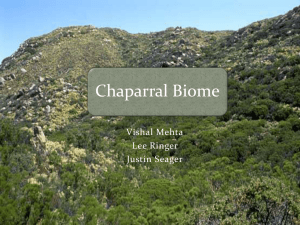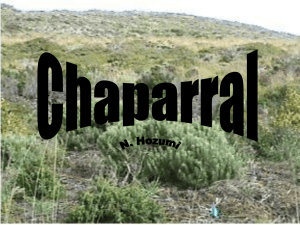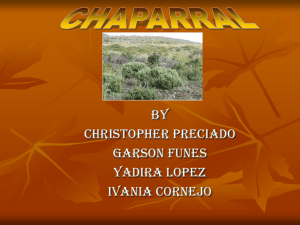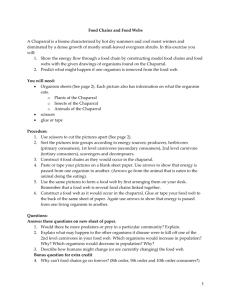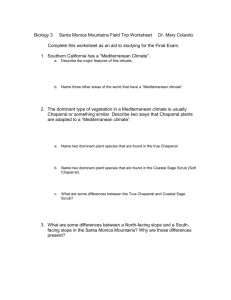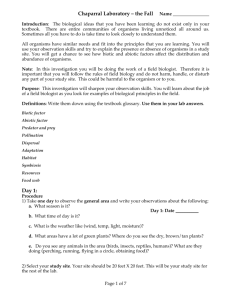Chaparral Mrs. Samsa 0 period
advertisement
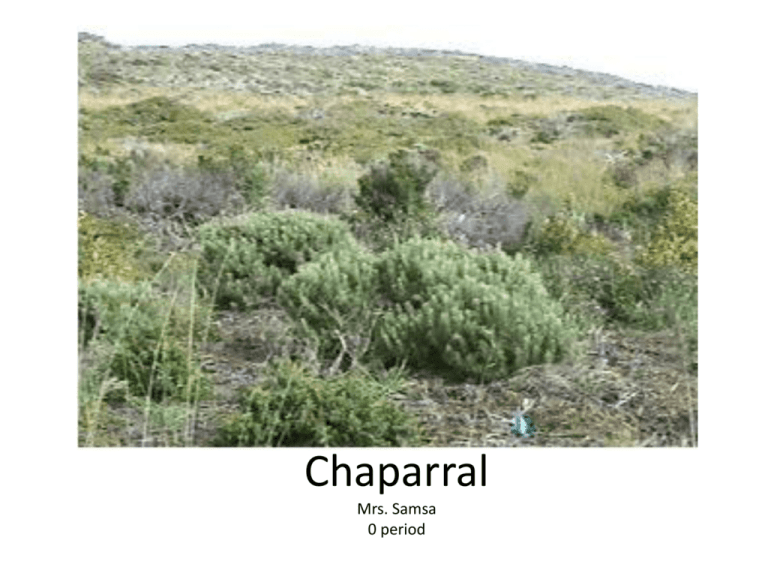
Chaparral Mrs. Samsa 0 period The chaparral biome is found in a little bit of most of the continents - the west coast of the United States, the west coast of South America, the Cape Town area of South Africa, the western tip of Australia and the coastal areas of the Mediterranean. Lay of the land: The chaparral biome has many different types of terrain. Some examples are flat plains, rocky hills and mountain slopes. It is sometimes used in movies for the "Wild West". Chaparral is characterized as being very hot and dry. As for the temperature, the winter is very mild and is usually about 10 °C. Then there is the summer. It is so hot and dry at 40 °C that fires and droughts are very common. Fortunately, the plants and animals are adapted to these conditions. Most of the plants have small, hard leaves which hold moisture. Some of these plants are poison oak, scrub oak, Yucca Wiple and other shrubs, trees and cacti. The animals are all mainly grassland and desert types adapted to hot, dry weather. A few examples: coyotes, jack rabbits, mule deer, alligator lizards, horned toads, praying mantis, honey bee and ladybugs. So, if you ever go somewhere t hat is like chaparral, make sure to bring some sunscreen and lots of water! The chaparral biome is found in a little bit of most of the continents - the west coast of the United States, the west coast of South America, the Cape Town area of South Africa, the western tip of Australia and the coastal areas of the Mediterranean. These areas are highlighted in green. Climate and Weather The summer season is very dry and can lasts up to five months. The dry summer makes the chaparral biome sensitive to fires. Occasional fires in the chaparral biome are helpful because they help balance out the living organisms and nonliving organisms. The average rainfall is 10 to 17 inches a year. During the winter, the temperature can get as low as 30° F and the summers can get up to 100° F. The average temperature in the chaparral biome is 64° F. Biotic Factors Common Sagebrush Fairy Duster Black Tailed Jackrabbit Blue Oak Golden Jackal Abiotic Factors Sunlight & temperature Soil & little yearly water Grey Fox – consumer (omnivore) Black Tailed Jackrabbit – consumer (omnivore) Cactus Wren – consumer (omnivore) Praying Mantis – consumer (omnivore) Manzanita - producer Fairy Duster - producer Torrey Pine - producer Do NOT use a pre-made food web! Predator – Prey Relationship Bezoar Goat A special adaptation of a goat is its wool which helps it survive the harsh mountain climate. Another adaptation is its horns, which it uses to defend itself and fight for females. Golden Jackal The Jackal is a predator and it helps the environment by keeping the rodent, goat, bird, and frog population down. In the winter it gets colder and the Jackal grows a thick coat of hair in preparation to this season. The Jackal has also adapted to eating insects. The chaparral biome has many problems. Lumberjacks are cutting down trees and destroying the vegetation. Humans kill animals in the chaparral, which disrupts the food chain. The most devastating problem is wild fires. These wildfires happen often to the land, or are started by humans. In nature some plants need fire to survive in the chaparral. It helps them to grow. These accidental or natural fires however can cause many houses to burn down. Some of the possible solutions that might help to save the chaparral include penalties for humans who start fires. Scientist have been conducting test in selected areas of the chaparral. They burned parts of the chaparral, to determine how to manage the fire and might what happen if it gets worse. They also live fire department equipment nearby so they can be prepared. Scientist are still trying to balance humans and nature so they can coexists in a way that is possible foe both of them. Invasive Species Spanish Broom (Spartium junceum) This invasive plant is a perennial shrub with cylindrical rush-like branches that are green when young and then turn brown as they mature. In addition, it is about 10-15 feet high. In California Spanish brooms are found in North Coast counties, the San Francisco Bay region, the Sacramento Valley, through South Coast counties to the Mexican border, in the western Transverse Ranges, and the Channel Islands. These species were planted along mountain highways in southern California. Following this, the Spanish broom spread rapidly therefore, producing seeds that are transported by any type of erosion or by rain wash. Spanish broom quickly colonizes disturbed habitats and develops thick shrub communities that prevent colonization by native soft or hard chaparral species. Plants grow to above the human head height and form a tangle containing a large amount of dead wood. Mature strands of Spanish broom should be considered a fire hazard during the dry season. The Spanish Broom creates a struggle for native wildlife.
